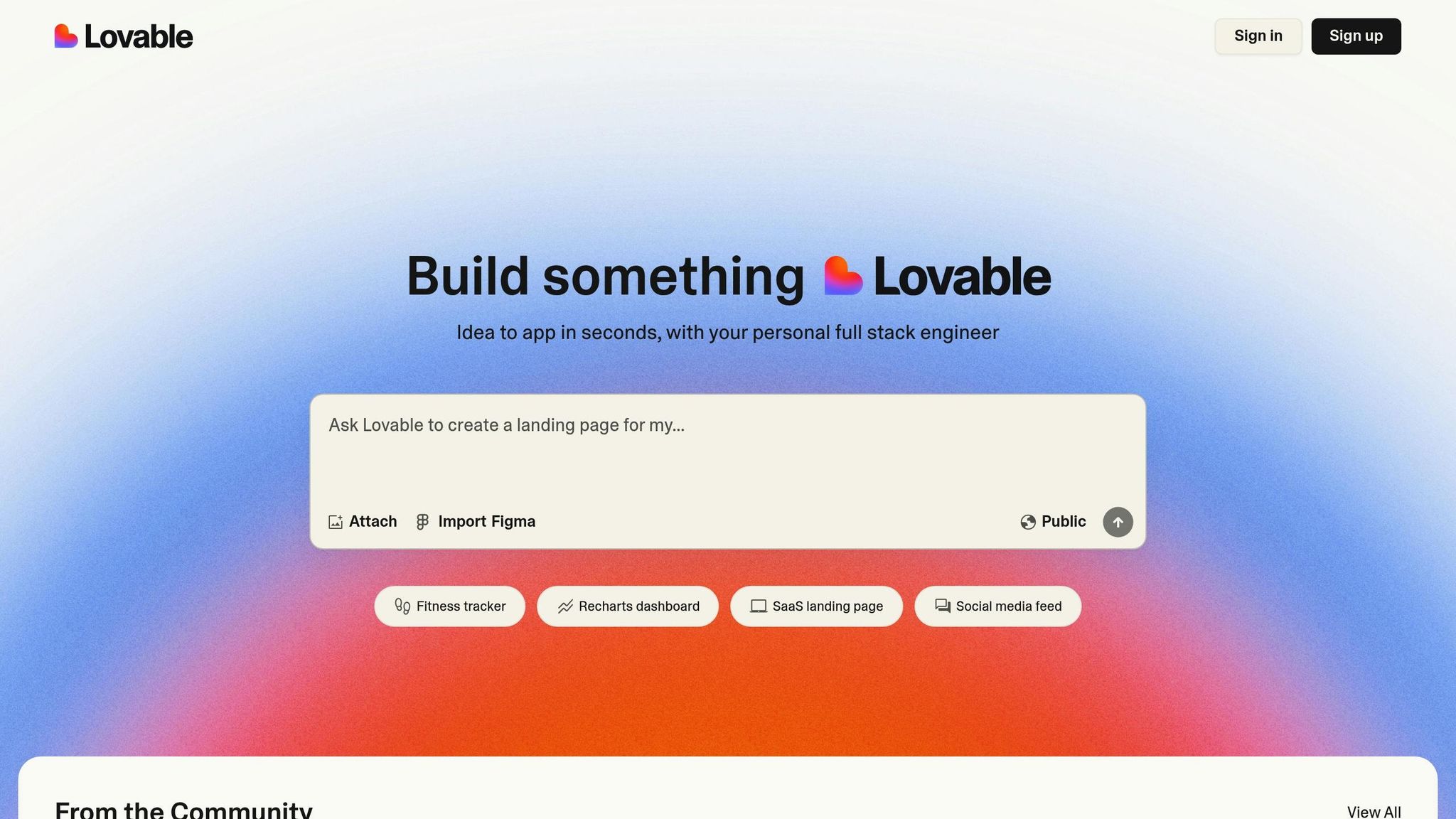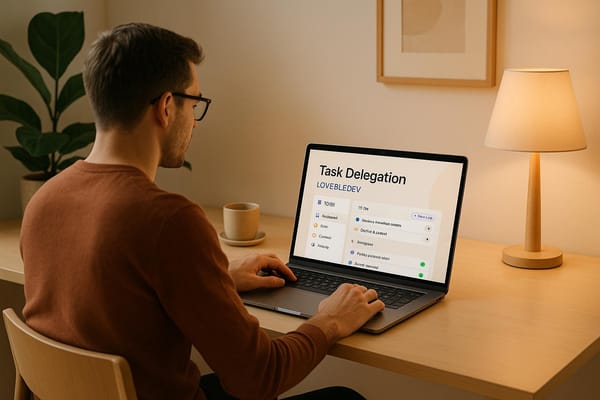Best Practices for Prompt Engineering on Lovable.dev
Learn effective strategies for prompt engineering on a no-code platform, enhancing app development with clarity and systematic planning.

With Lovable.dev, you can turn ideas into working apps by crafting clear instructions for its AI-powered full-stack engineer. Here's what you'll learn in this guide:
- Why clear prompts matter: Precise instructions lead to better, consistent results.
- How to fix common issues: Solve problems like vague instructions or unclear context.
- Step-by-step techniques: Break tasks into smaller steps, use visual references, and test for reliability.
Quick Tips for Better Prompts:
- Be specific: Instead of "make it look good", say "use a #0066CC button with 16px Roboto font."
- Divide tasks: Start with core features, then add complexity step-by-step.
- Use visuals: Include mockups or wireframes for clarity.
By following these strategies, you'll simplify app development and get reliable results every time.
7 Prompt Engineering Tips for Beginners! (Master Prompting)
Key Rules for Writing Prompts
These guidelines help developers make the most of Lovable.dev's prompt engineering, improving both app performance and development efficiency. Following a structured approach ensures reliable outcomes.
Write Clear Instructions
Clear and direct instructions are crucial for effective prompt engineering on Lovable.dev. Avoid ambiguity to reduce the chances of AI misinterpreting your intent:
| Instruction Element | Poor Example | Better Example |
|---|---|---|
| Action Verbs | "Make something for user input" | "Create a form with email and password fields" |
| Context | "Add a payment system" | "Integrate Stripe for USD payments" |
| Requirements | "Make it look good" | "Style the button with a #0066CC background, 16px Roboto font, and 8px border radius" |
Be as specific as possible when defining requirements. Once your instructions are clear, break down larger tasks into smaller, focused prompts for better results.
Break Down Large Tasks
When tackling complex projects, divide them into manageable steps. This approach ensures smooth progress and aligns with Lovable.dev's strengths.
- Core Functions: Start by implementing basic features like product listings or user authentication.
- Add Complexity Gradually: Enhance functionality step-by-step, such as introducing a shopping cart, enabling add/remove item features, calculating prices, and ensuring persistence.
- Integrate Components: Clearly define how different features should interact with each other.
Keep Instructions Uniform
After breaking down tasks, ensure consistency in how you present instructions. Uniformity helps maintain a cohesive development process.
- Stick to consistent terminology and formatting for features, styling, and behaviors.
- Clearly list any dependencies or prerequisites for each component.
Component: Navigation Menu
Purpose: User Interface
Dependencies: User Authentication Status
Required Styling: Match App Theme
Prompt Techniques for Lovable.dev

These techniques build on clear instructions and structured task breakdowns to improve your prompts on Lovable.dev.
Knowledge Base Setup
Create a knowledge base to ensure accurate responses on Lovable.dev. The platform supports image uploads in JPG, PNG, and WEBP formats, allowing you to include visual references for your app's requirements.
For better clarity, consider adding:
- Visual documentation: UI mockups, style guides, components, and interaction flows.
- Reference architecture: Data models, user flows, integration points, and feature dependencies.
Chat Mode and Diff & Select Tips
Leverage Chat Mode by structuring your prompts into distinct phases:
| Prompt Phase | Purpose | Example Format |
|---|---|---|
| Initial Request | Define base functionality | "Create a product listing component with image, title, and price" |
| Refinement | Specify adjustments | "Modify the product card to include a 'Save' button below price" |
| Validation | Confirm changes | "Show the updated component with the new button implementation" |
This phased approach ensures clarity and keeps your project moving forward with each interaction.
User Role Instructions
Clearly define user roles and permissions to manage access effectively:
| Role Type | Access Level | Typical Actions |
|---|---|---|
| Admin | Full | Database management, user control, system settings |
| Editor | Limited | Content updates, moderate user submissions |
| Viewer | Basic | View approved content, submit feedback |
Fix Common Prompt Problems
When working with Lovable.dev's AI system, a structured testing approach is key to ensuring your app runs smoothly.
Test and Check Results
Use a testing checklist to keep app performance consistent. Here's a quick breakdown:
| Testing Phase | Key Actions | Expected Outcome |
|---|---|---|
| Initial Validation | Run basic functionality tests | Confirm core features work properly |
| Edge Case Testing | Test boundary conditions | Identify potential failure points |
| Performance Check | Monitor response times | Ensure responses are efficient |
| Integration Testing | Verify component interactions | Confirm smooth functionality |
Be sure to document any unexpected behaviors or inconsistencies. This helps refine your prompts and improve overall performance.
Control Project Size
After testing, focus on keeping your project manageable to optimize AI performance:
- Start with the core features first, and only expand once these are solid.
- Break features into smaller, self-contained modules. This simplifies troubleshooting and ensures consistency.
- Add complexity step by step, validating simpler components before moving on.
Add Visual References
Once your project is modular and thoroughly tested, enhance your prompts by including clear visual references. These can make your guidelines easier to follow:
| Reference Type | Purpose |
|---|---|
| UI Mockups | Offer layout and design guidance |
| Wireframes | Show structure and flow |
| Component Examples | Highlight specific element details |
For maximum clarity, ensure your visual references are:
- Clearly labeled with key areas and components.
- Sized appropriately for quick review.
- Organized logically to avoid confusion.
Conclusion
Key Takeaways
To excel in prompt engineering on Lovable.dev, focus on three main principles:
- Clarity in instructions: Avoid ambiguity by being as precise as possible.
- Systematic planning: Break down complex features into smaller, manageable parts for easier development and upkeep.
- Consistent testing: Regularly test your prompts to ensure they produce dependable, high-quality results.
By sticking to these guidelines, you’ll create clear, modular instructions that lead to reliable outcomes.
Starting Your Journey
Lovable.dev makes it simple to build powerful apps with minimal coding. Start small - focus on creating one feature at a time. This method helps you:
- Learn the basics of prompt writing before diving into more intricate tasks.
- Perfect a single feature before adding more complexity.
- Build a strong foundation and expand only after validating each step.
Improving your prompt engineering skills takes practice. Begin with straightforward features, then work your way up to more advanced ones as you gain confidence. Use visuals to explain layouts, user interfaces, and functionality, ensuring your applications are both effective and user-friendly.
FAQs
What are the best practices for creating clear and effective prompts on Lovable.dev?
To craft clear and effective prompts on Lovable.dev, focus on being specific, concise, and goal-oriented. Start by clearly defining the desired outcome of your prompt and include all necessary details to guide the AI effectively. Avoid ambiguity, overly complex language, or unnecessary information that may confuse the system.
Here are a few tips to enhance your prompts:
- Be direct: Use straightforward language to describe what you need.
- Provide context: Include relevant details or examples so the AI can better understand the task.
- Iterate and test: Experiment with different prompt variations and refine based on the results.
By following these practices, you can optimize your prompts to improve your app's functionality and deliver a better user experience on Lovable.dev.
What are some common mistakes in prompt engineering on Lovable.dev, and how can I avoid them?
When crafting prompts for Lovable.dev, some common mistakes include being too vague, overloading prompts with unnecessary details, or failing to align the prompt with the app's functionality. These issues can lead to poor AI responses or confusion during app interactions.
To avoid these pitfalls, focus on clarity and specificity. Clearly define the desired outcome and provide concise instructions. Avoid including irrelevant or overly complex information that might confuse the AI. Additionally, test your prompts thoroughly to identify areas for improvement and ensure they align with the app's goals. Remember, well-crafted prompts are key to creating a seamless and engaging user experience.
How can using visual references improve the clarity and impact of my prompts on Lovable.dev?
Incorporating visual references into your prompts can significantly enhance their clarity and effectiveness by providing additional context and reducing ambiguity. Visuals, such as diagrams, charts, or images, help users quickly understand complex ideas and ensure your prompts are interpreted as intended. This can lead to more accurate outputs and a better user experience.
When crafting prompts on Lovable.dev, consider how visuals can complement your text. For example, if you're designing a prompt for an AI-generated layout, including a sample image or sketch can guide the system more effectively. By combining clear instructions with relevant visuals, you can optimize your prompts for better performance and results.



